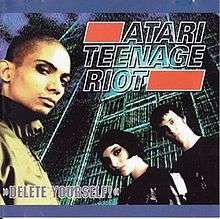Delete Yourself!
Delete Yourself! is the debut album by German music group Atari Teenage Riot.
| Delete Yourself! | ||||
|---|---|---|---|---|
 | ||||
| Studio album by | ||||
| Released | 1 March 1995 | |||
| Studio | Empire Studios Berlin Roundhouse Studios London | |||
| Length | 46:55 | |||
| Label | Digital Hardcore Recordings (Europe) Grand Royal (USA) | |||
| Producer | Alec Empire, David Harrow | |||
| Atari Teenage Riot chronology | ||||
| ||||
| Singles from Delete Yourself! | ||||
| ||||
| Original cover | ||||
 Original artwork for Delete Yourself!, originally titled 1995. | ||||
| Review scores | |
|---|---|
| Source | Rating |
| Allmusic | |
| Punk News | |
The song "Speed" was used in the 2006 film The Fast and the Furious: Tokyo Drift.[3]
Track listing
| No. | Title | Length |
|---|---|---|
| 1. | "Start The Riot!" | 3:40 |
| 2. | "Into The Death" | 3:26 |
| 3. | "Raverbashing" | 3:26 |
| 4. | "Speed" | 2:48 |
| 5. | "Sex" | 3:33 |
| 6. | "Midijunkies" | 5:15 |
| 7. | "Delete Yourself! (You Got No Chance To Win!)" (Live in Glasgow, 17.10.1993) | 4:37 |
| 8. | "Hetzjagd Auf Nazis!" (Live in Berlin, 25.2.1994) | 5:16 |
| 9. | "Cyberpunks Are Dead!" | 3:35 |
| 10. | "Kids Are United!" | 3:36 |
| 11. | "Atari Teenage Riot" | 3:38 |
| 12. | "Riot 1995" | 4:01 |
| Total length: | 46:55 | |
| No. | Title | Length |
|---|---|---|
| 13. | "Atari Teenage Riot" (1st Studio Recording) | 3:09 |
| 14. | "Children Of A New Breed" | 3:32 |
| 15. | "Riot Machine" | 5:25 |
| Total length: | 59:00 | |
Samples
Notes
- Allmusic review
- n/a. "Delete Yourself review". punknews.org. Punk News. Retrieved 2011-08-30.
- The Riot's kinetic classic 'Speed' is used on the 'Fast and Furious: Tokyo Drift' soundtrack, Digital Hardcore Recordings, last accessed 2006-09-27.
- Direct Sample of Dialogue, whosampled.com, last accessed 2018-3-28.
- Thanatos accuse Atari Teenage Riot of 'borrowing' one of their riffs Archived 2005-04-24 at the Wayback Machine, Blabbermouth.net, July 17, 2004, last accessed 2006-09-27.
gollark: Makes sense.
gollark: <@189841964454117378> Try Rust at some point. It's very nice.
gollark: <@189841964454117378>
gollark: Protip: what language are you using anyway?
gollark: Because chunks.
External links
This article is issued from Wikipedia. The text is licensed under Creative Commons - Attribution - Sharealike. Additional terms may apply for the media files.